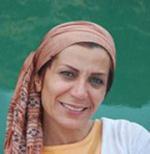Muslima Ambassador, Nikoo Tarkhani, interviews Mansoureh Shojaee, Iranian women's rights activist and co-founder of the Iran Women's Museum. Mansoureh talks about the Museum's tumultuous founding, the history of the Iranian women's movement, and her life in exile.
Nikoo Tarkhani: Can you give us a short summary of the Iran Women's Museum?
Mansoureh Shojaee: I had the idea for a women’s museum for such a long time. I started establishing libraries for women in 2000, like the Sedigheh Dowlatabadi Women’s Library and another library for women in Lar, Iran, so when Mrs. Shirin Ebadi suggested that we should have a women’s museum in Iran everything started. At the time, Shirin Ebadi was connected to the International Women's Museum Network and the Merano Women’s Museum in Italy. In addition to these networks, I began asking professional women in Iran to investigate the idea. I asked women in a variety of fields like art, history, and women’s studies. We held sessions to discuss the idea and eventually came to the conclusion that Iran needed an organization for collecting and documenting social history and the history of the Iranian women’s movement. The first task was to find a place for the museum and for this goal we needed funding. We decided that it would be problematic to ask for any funding from outside of Iran, so a group of artists gathered to hold an exhibition in aid of the museum. Even friends donated to our fund so that we could get the project off the ground. It is important to say that, in the end, we were not able to hold the exhibition. I had been arrested after the election and the project was aborted. We thought it would be a better strategy to establish local museums in smaller cities in order to prepare local women for the collecting and organizing of verbal history and information in their locale. We also launched an online organization out of Tehran which supervised and managed the project and coordinated programs for holding exhibitions. When I was in Iran I became in touch with the International Women's Museum Network, but as I mentioned before, I was arrested after the most recent presidential election. Later, I posted bail and left the country for Europe where I attended short educational terms in different women’s museums. During the first three or four months of my stay I was the trainer for museums in Norway, Italy and Germany. Now that I am living in Nuremberg, Germany I am cooperating with a women’s museum there.
Is this museum open to all women artists around the world or only Iranians?
What I had planned to do was to establish a museum that was focused only on events inside Iran. Now that I am outside and still working on the project the plan has changed and this museum is going to be for all Persian speaking women in Iran, Afghanistan, Tajikistan, and part of Uzbekistan. I hope it is done soon. Since it is now online I try to include as many women from different countries as I can. We have seen global networks and virtual women’s museums, but unfortunately our women cannot enter these networks or join these websites due to problems in the region or issues with translation. We will try to make it easier for the women in our region to enter such networks and then connect them more globally.
Can you give us a short explanation about the book, Shahrzad’s Sisters?
When I was in Iran I used to provide reports from deprived parts of Iran in hopes that it would help the museum archive one day. Thus the text and pictures shared the same importance in those reports. I asked professional photographers to help me in this matter. The first project of this series was, “Goat Seller Women of Minab.” I also had a report about a vocalist in Bandar Abbas, Iran named Ziba Shirvani who used to sing at weddings. After the Islamic Revolution she was arrested in a wedding and got lashed in public. Unfortunately, she passed away years ago. In 2009, when the International Women's Museum Network’s conference was held in Bonn, Germany, I was asked to introduce these reports. I was banned from travel in that time and asked my sister, who is living in Bonn and working for Deutsche Welle, to represent the series. Later, when I could travel to Germany, the museum in Nuremberg informed me that they wanted to publish the series under their museum publications. I had a scholarship from Pen Community and I was asked to introduce myself in Nuremberg. I decided to introduce the Iranian women’s movement instead and wrote something that was a bit poetic. The text was named “Shahrzad’s Sisters.” In this text I talked about myself, not as Mansoureh Shojaee, but as an Iranian woman who has been through a lot. This text was also accompanied by pictures like the rest of my reports. As a whole “Shahrzad’s Sisters” is a book consisting of various reports.
Can you tell us about The Feminist School?
After 2000, when the internet became very popular in Iran, women’s activity expanded. Women’s organizations were not allowed to have a newspaper, so they tried to be more active on the net. We felt the urge to create a website to represent the theoretical activities of the women’s movement. After the campaign, One Million Signatures, there were far more websites dedicated to women’s activities; The Feminist School was one of them. It was not an official subset of the One Million Signatures campaign instead, a group of members decided to create it. This website focuses on theoretical issues and that is why we chose to name it The Feminist School. This website works in the field of feminist criticism and literature. Some of the contents are from Iranian women and some are from elsewhere and then translated.
As an activist how do you evaluate the situation of women in Iran?
The Iranian women’s movement is more than one hundred years old. This means that almost right after the Constitutional Movement and the birth of the concept of “rights” in Iran, the Iranian women’s movement was shaped. At first the Iranian women’s movement was in-line with the Constitutional Movement in objecting to monarchy and totalitarianism, but after the enactment of law the Iranian women’s movement started its own objections for there were no rights for women under the law! Women, children, and insane people were not allowed to vote! In 1908 the first protests began, only one year after the Constitutional Movement in Iran. If we add individual activities to that we may say that Iranian women’s movement started as much as 25 years earlier! When Tahereh Ghoratolein rhymed about the lack of freedom of expression and imposed hijab more than one hundred years ago what may we call it other than a cultural objection? The Iranian women’s movement had its successes and failures. It restored women’s right to vote, but was unsuccessful in restoring the right to wear whatever one chooses after The Islamic Revolution. Even intellectuals did not pay attention to what women were forced to wear and not wear. I believe this is because the country had just been through a revolution and it seemed unstable. A decade after The Revolution women’s rights became an important issue again. Woman could enter Parliament and succeed in certain ways, but their main request was to join the international movement to eliminate all forms of discrimination against women that they felt they could not achieve alone.
How did you pursue your activities in Iran? There must have been a lot of problems.
Yes, even when Mohammad Khatami was the President, women activists sent requests to Parliament, but the results were not what they had anticipated. Some movements even occurred during Ahmadinejad’s presidency; like the campaign of One Million Signatures, the Coalition for Convergence of Women’s Demands, and the Big Coalition for Family. There are numerous exhibitions and movies based on these ideas and requests, but unfortunately governments thought they should stop these movements and so there it begins: denying access to certain websites, closing many libraries, restricting magazines and newspapers, and separating male and female students in universities. New unjust rules became part of the law, like the law that no woman under forty is allowed to leave the country without a certification from her male protector! We may say that women in Iran are fighting an endless war. They succeed in certain matters and get what they deserve. We have so many successful women in the fields of art and culture, but for that we cannot say the situation of women is acceptable. We will only accept women’s situation when women and men share the same right by the law. For example, when a woman’s share of inheritance is equal to that of her male siblings, and when a man and a woman share the same rights in matrimonial rules, etc.
A few years ago you and your colleagues were collecting signatures for a campaign. Can you tell us about the campaign known as “One Million Signatures?”
The campaign started in 2006. It was a movement that involved both secular and religious groups. The main request of this campaign was to eliminate all of the discriminating rules against women. We did not collect signatures online. We only collected physical signatures. However, we did use the web for certain things. We published a guidance book online and also held online classes to teach the rules in constitutional law that support discrimination against women. Then we asked citizens to sign the physical paper if they agreed with our philosophies. The signatures were supposed to be sent to Parliament when they reached one million.
But all of those activities were shut down by the government, correct?
Yes, the fact is I do not think that there is a more civil way to show our requests and demands. Unfortunately, the government could not take it. They closed the workshops in the most hostile way. They also shut down the campaign. Any related activity was called illegal and judged a crime. As I have said earlier, women in Iran are fighting a constant battle and despite all of the problems women activists are still working.
- Log in to post comments




